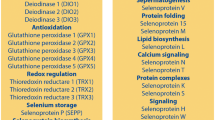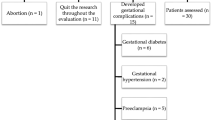Abstract
Placenta tissue may be a major source of lipid peroxidation products in pregnancy. It was proven that placental peroxidation activity increases with gestation. Selenium (Se), as an essential constituent of glutathione peroxidase (GSH-Px), takes part in the reduction of hydrogen peroxides and lipid peroxides. Malondialdehyde (MDA) is a major breakdown product split off from lipid peroxides. In this study, Se and MDA content and GSH-Px activity were measured in blood and plasma taken from 20 apparently healthy nonpregnant women between 19 and 38 yr of age and from 115 unselected pregnant women between 17 and 45 yr of age (35 in the first trimester, 22 in the second trimester, 38 in the third trimester, and 20 within 2 d of delivery). Samples of umbilical cord blood and amniotic fluid were taken from women in the second and third trimesters and at delivery. The Se content was measured by atomic absorption spectrometry (AAS), plasma MDA concentration by thiobarbituric acid reaction, and Se-dependent GSH-Px spectrometrically. Blood and plasma Se contents of nonpregnant women were below those considered adequate, indicating low selenium intake. In comparison to nonpregnant women, pregnant women had significantly decreased whole-blood and plasma Se levels in the second and third trimesters and at delivery. The significant drop of whole-blood SeGSH-Px activity was observed in the first trimester of pregnancy and its lower activity was maintained until delivery. A significant drop in plasma SeGSH-Px activity occurred in the second trimester and attained the minimal level at delivery. The Se level and SeGSH-Px activity in maternal and umbilical cord blood were at similar levels. Amniotic-fluid SeGSH-Px activity was nondetectable or exceptionally low and its Se content remained unchanged during pregnancy. Plasma levels of MDA were significantly decreased in the second and third trimesters and at delivery. The fetal blood plasma at birth had a lower MDA level compared to the levels of MDA of their mothers at delivery. A low, but significant inverse correlation existed between blood SeGSH-Px activity and plasma MDA content and between plasma Se and plasma MDA contents during pregnancy. A significant decrease of Se and SeGSH-Px activities (antioxidant enzyme) in both blood and plasma suggests a possible drop in total antioxidant status during pregnancy. Elevated MDA plasma levels might be the result of increased lipid peroxidation in placental tissue during pregnancy.
Similar content being viewed by others
References
D. Wickens, M. N. Wilkins, J. Lunec, G. Ball, and H. Dormandy, Free radical oxidation (peroxidation) products in plasma in normal and abnormal pregnancy, Ann. Clin. Biochem. 18, 158–162 (1981).
C. A. Hubel, J. M. Roberts, R. N. Taylor, T. J. Musci, G. M. Rogers, and M. K. McLaughlin, Lipid peroxidation in pregnancy: new perspectives on preeclampsia, Am. J. Obstet. Gynecol. 161(4), 1025–1034 (1989).
S. Diamant, R. Kissilevitz, and N. Diamant, Lipid peroxidation in placental tissue: general properties and influence of gestation age, Biol. Reprod. 23, 776–781 (1980).
L. G. Snotnikova, A. V. Naumov, and V. A. Kuznetsova, The value of some parameters of erythrocyte membrane lipid peroxidation in late gestosis, Akush. Ginekol. (Mosk) 4, 20–22 (1986).
Y. Wang and S. W. Walsh, Antioxidant activities and mRNA expression of superoxide dismutase, catalase and glutathione peroxidase in normal and preeclamptic placentas, J. Soc. Gynecol. Invest. 3(4), 179–184 (1996).
M. Ishihara, Studies on lipoperoxide of normal pregnant women and of patient with toxemia of pregnancy, Clin. Kim. Acta 81, 1–9 (1978).
M. Maseki, I. Nishigaki, M. Hagihara, Y. Tomoda, K. Yagi, Lipid peroxide levels and lipid serum content of serum lipoprotein fractions of pregnant subjects with and without pre-eclampsia, Clin. Kim. Acta 155, 155–161.
C. Little and P. J. O’Brien, An intracellular GSH-peroxidase with a lipid peroxide substrate, Biochem. Biophys. Res. 31, 145–150 (1968).
D. Behne and W. Wolters, Selenium content and glutathione peroxidase activity in the plasma and erythrocytes of non-pregnant and pregnant women, J. Clin. Chem. Clin. Biochem. 17, 133–135 (1979).
B. Weltty, M. S. Wolynetz, and M. Verlingen, Interlaboratory trial on the determination of selenium in lyophilized human serum, blood and urine using hydride generation atomic absorption spectrometry, Appl. Chem. 59(7), 927–936 (1987).
W. A. Günzler, H. Kremers, and L. Flohé, An improved coupled test procedure for glutathione peroxidase (EC 1.11.1.9) in blood, Z. Klin. Chem. Biochem. 12, 144–148 (1974).
R. F. Burck, K. Nishiki, R. A. Lawrence, and B. Chance, Peroxide removal by selenium dependent and selenium independent glutathione peroxidase in hemoglobin-free perfused rat liver, J. Biol. Chem. 253, 43–46 (1978).
S. Sankari, Plasma glutathione peroxidase and tissue selenium response to selenium supplementation in swine, Acta Vet. Scand. 81 (Suppl.), 1–127 (1985).
M.J. Grotti, N. Khan, and D. A. McLelland, Early measurement of systemic lipid peroxidation products in plasma of major blood trauma patients, J. Trauma 3191, 32–35 (1991).
M. B. Mihailović, P. Lindberg, and I. Jovanović, Selenium content in feedstuffs in Serbia, Acta Vet. (Belgrade) 46(5–6), 343–348 (1996).
M. B. Mihailović, P. Lindberg, I. Jovanović, and D. Antić, Selenium status of patients with Balkan endemic nephropathy, Biol. Trace Element Res. 33, 71–77 (1992).
H. Korpela, R. Loueniva, E. Yrjanheikki, and A. Kuppila, Selenium concentration in maternal and umbilical blood, placenta and amniotic membranes, Int. J. Vitam. Nutr. Res. 54(2–3), 257–261 (1984).
R. Karunanithy, A. C. Roy, and S. S. Ratnam, Selenium status in pregnancy: studies in amniotic fluid from normal pregnant women, Gynecol. Obstet. Invest. 27(3), 148–150 (1989).
E. N. Frankel and W. E. Neff, Formation of malonaldehyde from lipid oxidation product, Biochim. Biophys. Acta 754, 264–270 (1983).
T. Tomita, K. Umegaki, and E. Hayashi, Basic aggregation properties of washed rat platelets: correlation between aggregation, phospholipid degradation, malonaldehyde and tromboxane formation, J. Pharmacol. Methods 10, 31–34 (1983).
Author information
Authors and Affiliations
Rights and permissions
About this article
Cite this article
Mihailović, M., Cvetković, M., Ljubić, A. et al. Selenium and malondialdehyde content and glutathione peroxidase activity in maternal and umbilical cord blood and amniotic fluid. Biol Trace Elem Res 73, 47–54 (2000). https://doi.org/10.1385/BTER:73:1:47
Received:
Accepted:
Issue Date:
DOI: https://doi.org/10.1385/BTER:73:1:47




